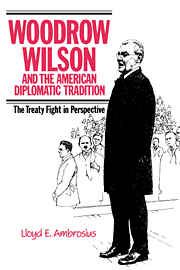Book contents
- Frontmatter
- Contents
- Preface
- Acknowledgments
- List of abbreviations
- 1 Introduction: Wilson's new world
- 2 Origins of Wilson's league of nations idea
- 3 Drafting of the League of Nations Covenant
- 4 American criticism of Wilson's peacemaking
- 5 Revision of the League of Nations Covenant
- 6 The question of control at home and abroad
- 7 The Versailles Treaty in the Senate
- 8 American rejection of the Versailles peace
- 9 The aftermath of Wilson's peacemaking
- 10 Epilogue: Wilson's legacy
- Bibliography
- Index
2 - Origins of Wilson's league of nations idea
Published online by Cambridge University Press: 18 September 2009
- Frontmatter
- Contents
- Preface
- Acknowledgments
- List of abbreviations
- 1 Introduction: Wilson's new world
- 2 Origins of Wilson's league of nations idea
- 3 Drafting of the League of Nations Covenant
- 4 American criticism of Wilson's peacemaking
- 5 Revision of the League of Nations Covenant
- 6 The question of control at home and abroad
- 7 The Versailles Treaty in the Senate
- 8 American rejection of the Versailles peace
- 9 The aftermath of Wilson's peacemaking
- 10 Epilogue: Wilson's legacy
- Bibliography
- Index
Summary
Before the outbreak of the World War in Europe, Wilson had developed the themes which would characterize his policy of neutrality. “There is,” he said in reference to the Mexican Revolution, “only one possible standard by which to determine controversies between the United States and other nations, and that is compounded of these two elements: Our own honor and our obligations to the peace of the world.” From 1914 to 1917 the president attempted to protect American neutral rights, identifying them with national honor and independence. At the same time he hoped to end the war. Twice during the period of neutrality, Wilson's most intimate adviser, Edward M. House, traveled to Europe in search of peace between the Allies and the Central Powers. Out of these attempts at mediation grew the idea of a league of nations. In Wilson's mind, it represented no sharp break from the diplomatic tradition. American mediation and a new league promised world peace, which would protect neutral rights. Neutrality and the league idea reflected his twin desires to isolate the United States and to redeem the Old World. The same conception of the American mission underlay his official neutrality and his emerging conception of collective security.
Throughout the fall of 1914, House attempted in vain to convince the belligerents to accept mediation. With the president's approval, he sought to open negotiations by working through European ambassadors in Washington. Concentrating especially on the British and German ambassadors, Sir Cecil Spring Rice and Count Johann von Bernstorff, House proposed “a durable peace” on the basis of ending militarism and restoring Belgium.
- Type
- Chapter
- Information
- Woodrow Wilson and the American Diplomatic TraditionThe Treaty Fight in Perspective, pp. 15 - 50Publisher: Cambridge University PressPrint publication year: 1987
- 1
- Cited by



